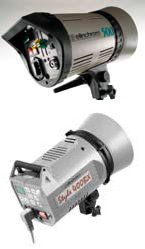articles/Lighting/letlight-page2
Let There be Light 2005 - part 2 of 1 2 3
by Mike McNamee Published 01/09/2005

As far as possible we have made our selection expandable, with minimum redundancy of kit - if you get rich quick and rent a studio, keep hold of your old gear as a "ready to go" grab-pack for quickie shoots away from home.
We will not be discussing camera and lens selection. Terry Hansen has a succinct answer to the question "which camera should I buy?" It is, "the first one for which you can afford two of them".

How Much Power?
Things like Guide Numbers are OK for small, on-camera flashes but lose their meaning a little in the studio, where the output of the head in joules is the baseline and the total light reaching the subject is the product of the output of the head and the diffusing power of the light modifier (be it an umbrella, reflector, light-box or some other gizmo). For most run-of-the-mill portraiture (in a domestic-sized room) a head with an output of 250 or 500 joules is about right. When buying a number of heads, most people prefer to mix 250s and 500s to provide a bit more flexibility. Beware of going bigger "just in case". Your Editor's system was specified for industrial product work on 5x4 tranny at f128. Turn this little lot of 1,500 joule beasts onto a model and she will need to reapply her make-up after the first shot! Even turned down to 1/32nd power you are still forced to use about f11 in a small studio which can be quite inappropriate. In addition, a 1500 joule unit is quite large, quite heavy and needs a more robust stand - you very rapidly build up the weight that you have to get into a building.
Please Note:
There is more than one page for this Article.
You are currently on page 2 Contact Mike McNamee
1st Published 01/09/2005
last update 09/12/2022 14:55:44
More Lighting Articles
There are 0 days to get ready for The Society of Photographers Convention and Trade Show at The Novotel London West, Hammersmith ...
which starts on Wednesday 15th January 2025





